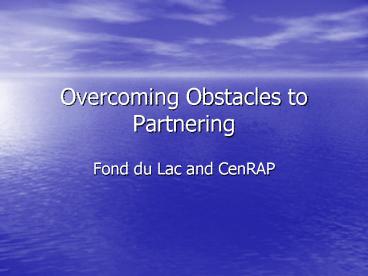Overcoming Obstacles to Partnering PowerPoint PPT Presentation
1 / 8
Title: Overcoming Obstacles to Partnering
1
Overcoming Obstacles to Partnering
- Fond du Lac and CenRAP
2
Introduction
- The 1999 Regional Haze Rule called for the
creation of Regional Planning Organizations, or
RPOs, where states and tribes would come
together to address regional haze. - The Central Regional Air Planning Association is
an offshoot of CenSARA, an organization of nine
midwestern state air agencies, including
Minnesota, where FdL is located. - When CenRAP was created as a sister agency to
CenSARA, tribes wanted to be included.
3
Obstacles
- States were not used to working with tribes and
went ahead and started writing bylaws, with the
intent of bringing tribes in later. - Tribes in the nine-state areas wanted to be
involved from the on-set. - Some CenRAP states were not very enthusiastic
about including tribes, or didnt understand why
tribes wanted to be included. - Broad geographic areas covered in this region
includes a broad array of political and cultural
views. - The original draft by-laws had very limited
tribal representation.
4
Why Did Tribes Want to Be Involved?
- RPOs were seen as the wave of the future and
tribes wanted to be included from the start. - Visibility can be an important cultural value.
- The same pollutants that influence visibility
affect health. - Getting involved in this group could lead to
great contacts for tribes to utilize. - Promotes state/tribal relations.
5
How did Tribes Overcome Obstacles?
- Going to the funding source (EPA) and reminding
them of their trust responsibility. - Once tribes were in the meetings, we needed to
prove ourselves. We did this by reminding the
states what we had to offer, showing up
consistently (even though this is not always
easy), taking on tasks, serving as co-chairs of
working groups, and working professionally with
the states. - It helped that there was a deadline for regional
haze SIPs. Issues of representation had to be
settled so the group could move forward.
6
Outcomes
- Tribes gained nine seats on the policy oversight
group (POG), same as the states. - Partnerships were formed between states and
tribes for monitoring. - Tribes hold the Vice-President and
Secretary/Treasurer positions on the POG. - Both states and tribes participate together on
the POG, Steering Committee, and workgroups. - Work was completed with only legislative delays.
- State/tribal work continues..
7
Partnerships Formed
- Both states and tribes have attended CenRAP
training in data management. - Both attended Blue Skyways and Smoke Management
sessions. - Minnesota Pollution Control Agency and MN tribes
have a permitting notification agreement for air,
and one in the works for water. - Cherokee and Sac and Fox Nations are filling
important monitoring gaps. - States have come to learn about our
funding/staffing issues. - Valuable contacts have been made between states,
tribes, FLMs, EPA, CenRAP, etc.
8
Working Professionally
- Show that we are here not solely to shoot things
down nor to rubber stamp we are here to get
things done the best way possible. - We are willing to learn and also have much to
teach. - Work within the regulatory framework.
- Let others know that we care about the same
issues.

